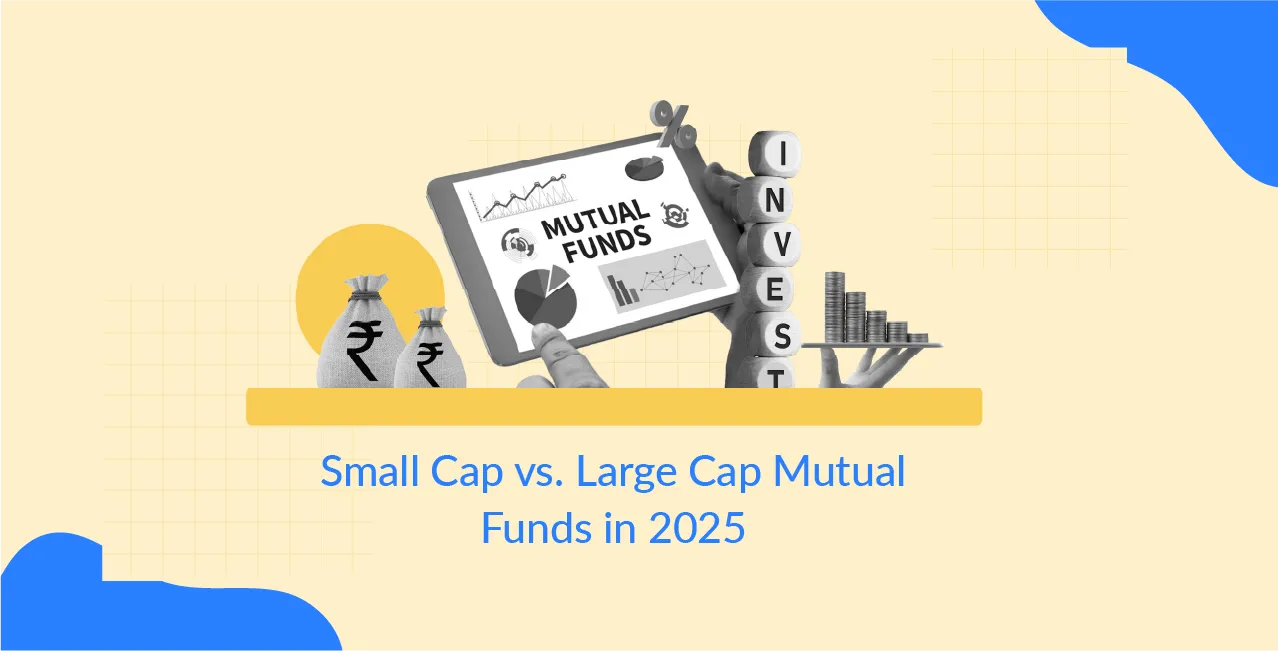
Author
LoansJagat Team
Read Time
4 Min
10 Jul 2025
Small Cap vs. Large Cap Mutual Funds in 2025: Where Should New Indian Investors Bet?
Small Cap vs. Large Cap Mutual Funds in 2025: Where Should New Indian Investors Bet?
In 2025, many new Indian investors are choosing between small-cap and large-cap mutual funds. Understanding their risks, returns, and roles can help you make the right investment decision.
1. Small‑caps offer strong long-term growth but are highly volatile
Small-cap mutual funds invest in companies with small market capitalisation. These funds offer excellent long-term growth potential. However, they come with high volatility. Prices can swing dramatically in short periods. New investors must understand this risk-reward balance.
Small-cap companies are often emerging businesses. They have room for significant expansion. This creates wealth-building opportunities. But market downturns hit them harder than large companies. Patience is essential for small-cap investing.
Jay's Small-Cap Investment Example
Jay invested ₹5,000 monthly in small-cap funds. Initially, he faced losses during market corrections. However, persistence paid off. His wealth grew substantially over time. This demonstrates small-cap volatility and long-term potential.
2. Large‑caps bring stability, though returns are modest
Large-cap mutual funds invest in established companies. These firms have strong market positions. They offer steady growth with lower risk. Returns are moderate but predictable. New investors prefer stability over high returns.
Large-cap funds suit conservative investors. They provide regular dividends. Market downturns affect them less. Recovery happens faster than small-caps. Professional fund managers handle investments.
Read More - Best Time to Invest in Mutual Funds in 2025 – Month-by-Month Guide
Mayank's Large-Cap Investment Example
Mayank invested ₹5,000 monthly in large-cap funds. His portfolio showed steady growth each year. No major losses occurred during market corrections. Returns were modest but consistent. This demonstrates large-cap stability and reliable wealth building.
3. Mixing categories balances risk and reward
Mixing small-cap and large-cap mutual funds creates a balanced portfolio. This strategy combines growth potential with stability. Large-cap funds provide steady returns during market downturns. Small-cap funds boost overall portfolio growth during good times. This diversification reduces risk whilst maintaining upside potential.
A balanced approach suits most new investors. It prevents putting all eggs in one basket. Market volatility affects different fund categories differently. When small-caps fall, large-caps often remain stable. This balance protects your investment capital.
Kunal's Mixed Portfolio Example
Kunal split his ₹5,000 monthly investment: ₹3,000 in large-cap and ₹2,000 in small-cap funds. This balanced approach reduced volatility whilst capturing growth opportunities.
4. Time horizon and risk appetite are key
Time horizon and risk appetite determine your investment choice. Young investors with long-term horizons can handle higher risk. They have years to recover from market downturns. Short-term investors need stability over growth. Risk appetite varies with personal circumstances and financial goals.
Those comfortable with volatility choose small-caps for higher returns. Conservative investors prefer large-caps for steady growth. Your investment timeline matters most. Longer periods smooth out market fluctuations naturally.
Prince's Investment Comparison
Prince matched his investment choices with specific goals. Short-term needs required stable large-cap funds. Long-term wealth building used high-growth small-cap funds. This strategic approach optimised his financial planning.
5. Market context matters—economy and sector trends count
Market context significantly influences fund performance. Economic cycles affect small-cap and large-cap funds differently. During economic growth, small-caps outperform dramatically. In uncertain times, large-caps provide better protection. Sector trends also impact returns substantially.
Global events, government policies, and interest rates shape market behaviour. Technology booms favour growth-oriented small-caps. Banking sector strength supports large-cap stability. Smart investors adjust their allocation based on current market conditions.
Rajiv's Market-Based Investment Strategy
Rajiv adjusted his fund allocation based on market conditions. He increased small-cap exposure during favourable times and reduced it during uncertainty. This tactical approach maximised his returns whilst managing risk effectively.
Also Read - Nifty Midcap 50 Stocks List – Latest 2025 Constituents
Conclusion
New Indian investors should balance small-cap and large-cap funds based on risk tolerance and goals. Small-caps offer high growth but are risky, while large-caps provide steady, safer returns. Diversify wisely.
FAQs
1. Which is riskier, small-cap or large-cap funds?
Small-cap funds are riskier but can give higher returns over time.
2. Are large-cap funds good for beginners?
Yes, large-cap funds are stable and better for new investors.
3. Should I invest in both small and large-cap funds?
A mix of both balances risk and growth for most investors.
4. How long should I stay invested in small-cap funds?
Small-caps need at least 5-7 years to reduce risk and get good returns.
Other Related Pages | |||
Why More Indians Are Choosing Gold Loans Over Fixed Deposits in 2025 | |||
About the Author

LoansJagat Team
‘Simplify Finance for Everyone.’ This is the common goal of our team, as we try to explain any topic with relatable examples. From personal to business finance, managing EMIs to becoming debt-free, we do extensive research on each and every parameter, so you don’t have to. Scroll up and have a look at what 15+ years of experience in the BFSI sector looks like.

Quick Apply Loan
Subscribe Now


